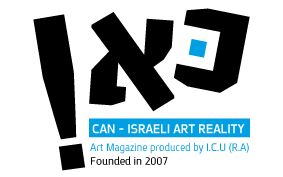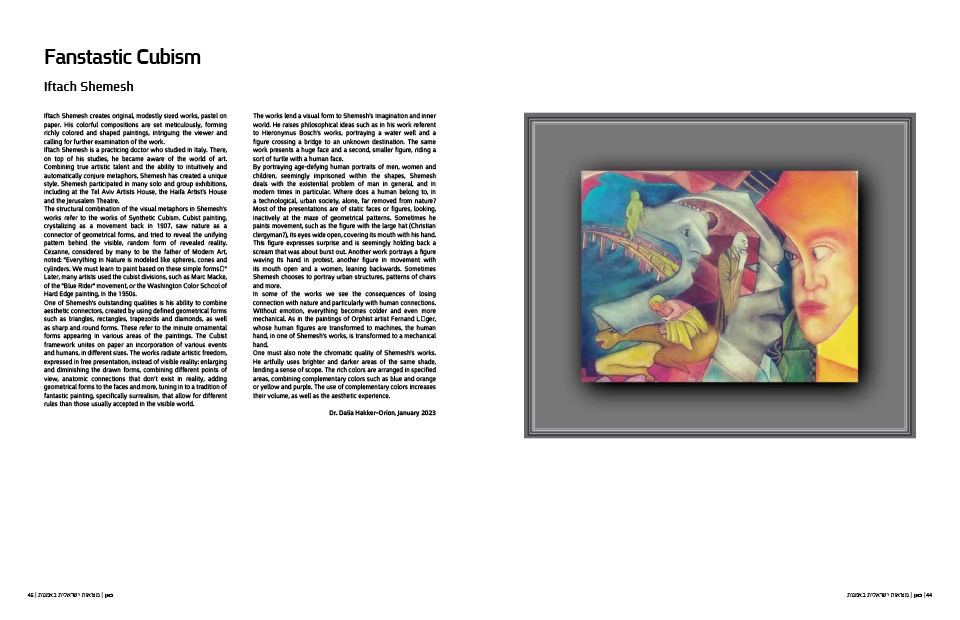
| Home Page | Editor Notices | Museums | Galleries | Publication | Donation | Contact Us |


 | |||||||||||||||
| |||||||||||||||


| |||||||||||||||
| Iftach Shemesh |
Iftach Shemesh creates original, modestly sized works, pastel on paper. His colorful compositions are set meticulously, forming richly colored and shaped paintings, intriguing the viewer and calling for further examination of the work. Iftach Shemesh is a practicing doctor who studied in Italy. There, on top of his studies, he became aware of the world of art. Combining true artistic talent and the ability to intuitively and automatically conjure metaphors, Shemesh has created a unique style. Shemesh participated in many solo and group exhibitions, including at the Tel Aviv Artists House, the Haifa Artist's House and the Jerusalem Theatre. The structural combination of the visual metaphors in Shemesh's works refer to the works of Synthetic Cubism. Cubist painting, crystalizing as a movement back in 1907, saw nature as a connector of geometrical forms, and tried to reveal the unifying pattern behind the visible, random form of revealed reality. Cezanne, considered by many to be the father of Modern Art, noted: "Everything in Nature is modeled like spheres, cones and cylinders. We must learn to paint based on these simple forms…" Later, many artists used the cubist divisions, such as Marc Macke, of the "Blue Rider" movement, or the Washington Color School of Hard Edge painting, in the 1950s. One of Shemesh's outstanding qualities is his ability to combine aesthetic connectors, created by using defined geometrical forms such as triangles, rectangles, trapezoids and diamonds, as well as sharp and round forms. These refer to the minute ornamental forms appearing in various areas of the paintings. The Cubist framework unites on paper an incorporation of various events and humans, in different sizes. The works radiate artistic freedom, expressed in free presentation, instead of visible reality: enlarging and diminishing the drawn forms, combining different points of view, anatomic connections that don't exist in reality, adding geometrical forms to the faces and more, tuning in to a tradition of fantastic painting, specifically surrealism, that allow for different rules than those usually accepted in the visible world. The works lend a visual form to Shemesh's imagination and inner world. He raises philosophical ideas such as in his work referent to Hieronymus Bosch's works, portraying a water well and a figure crossing a bridge to an unknown destination. The same work presents a huge face and a second, smaller figure, riding a sort of turtle with a human face. By portraying age-defying human portraits of men, women and children, seemingly imprisoned within the shapes, Shemesh deals with the existential problem of man in general, and in modern times in particular. Where does a human belong to, in a technological, urban society, alone, far removed from nature? Most of the presentations are of static faces or figures, looking, inactively at the maze of geometrical patterns. Sometimes he paints movement, such as the figure with the large hat (Christian clergyman?), its eyes wide open, covering its mouth with his hand. This figure expresses surprise and is seemingly holding back a scream that was about burst out. Another work portrays a figure waving its hand in protest, another figure in movement with its mouth open and a women, leaning backwards. Sometimes Shemesh chooses to portray urban structures, patterns of chairs and more. In some of the works we see the consequences of losing connection with nature and particularly with human connections. Without emotion, everything becomes colder and even more mechanical. As in the paintings of Orphist artist Fernand L?ger, whose human figures are transformed to machines, the human hand, in one of Shemesh's works, is transformed to a mechanical hand. One must also note the chromatic quality of Shemesh's works. He artfully uses brighter and darker areas of the same shade, lending a sense of scope. The rich colors are arranged in specified areas, combining complementary colors such as blue and orange or yellow and purple. The use of complementary colors increases their volume, as well as the aesthetic experience. Dr. Dalia Hakker-Orion, January 2023 Read more  |
| all rights reserved - CAN ISRAELI ART REALITY |
| סייבורג מחשבים - בניית אתרים |